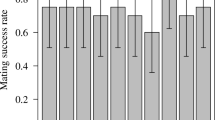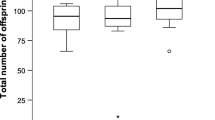Summary
In ants, because males have a finite sperm supply and females mate only at the beginning of their reproductive lives, it is possible to infer which is the limiting sex from a few parameters: the amount of sperm produced by males, the amount of sperm stored by females, and the numerical sex ratio. In the Argentine ant Iridomyrmex humilis mating takes place in the nest. Laboratory experiments and field data showed that the numerical sex ratio is heavily male-biased (10.1:1) and that the maximum number of sperm a female can store is similar to the number of sperm a male possesses. Thus females are the limiting sex in this species. In a set of mating experiments, one queen was presented with 1–20 males. The highest proportion of successful matings occurred when females were presented with two males. There was a significant negative correlation between the amount of sperm queens stored and the number of males present in the mating arena. This relationship most likely resulted from male interference during the copulation process. When several males were present in the arena, the mating pair was frequently disturbed by other males trying to copulate. Newly mated queens collected from the field stored 172,000 ± 76,000 sperm, a quantity most similar to that measured in laboratory mating experiments with a ratio of 5 or 10 males per queen. Because the operational sex ratio in I. humilis is highly male-biased, male interference may also decrease the amount of sperm queens store in the field. In many ants, fewer sperm stored by queens should decrease their reproductive success because they would run out of sperm earlier in their reproductive lifetimes. However, comparison of the amount of sperm present in young and old I. humilis queens collected in the field suggests that most use only a small proportion of their sperm supply during their lifetimes. Males mate once and discharge all their sperm during a single mating. Females may mate with several males but dissection of these males indicated that in most cases only one of them had empty seminal vesicles thus suggesting that a single male is responsible for most of the sperm transfer. Thus caution should be exercised in inferring multiple inseminations, as is frequently done in eusocial insects, from the observation of multiple copulations.
Similar content being viewed by others
References
Alcock J, Eickwort GC, Eickwort KR (1977) The reproductive behavior of Anthium maculosum (Hymenoptera: Megachilidae) and the evolutionary significance of multiple copulations by females. Behav Ecol Sociobiol 2:385–396
Ball DE, Vinson SB (1983) Mating in the fire ant, Solenopsis invicta Buren: Evidence that alates mate only once. J Ga Entomol Soc 18:287–291
Bartels PJ (1983) Polygyny and the reproductive biology of the Argentine ant. Ph D Thesis, University of California, Santa Cruz
Benois A (1973) Incidences des facteurs écologiques sur le cycle annuel et l'activité saisonnière de la fourmi d'Argentine Iridomyrmex humilis (Mayr) (Hymenoptera, Formicidae), dans la région d'Antibes. Insectes Soc: 20:267–296
Blum MS, Blum NA (1979) Sexual selection and reproductive competition in insects. Academic Press, New York
Bulmer M (1983) Sex ratio evolution in social hymenoptera under worker control with behavioral dominance. Am Nat: 121 899–902
Buschinger A, Alloway TM (1979) Sexual behaviour in the slave-making ant Harpagoxenus canadensis, H. americanus (Emery), and H. sublaevis (Nylander) (Hymenoptera: Formicidae). Z Tierpsychol 49:113–119
Cherix D, Chautems D, Fletcher DJC, Fortelius W, Gris G, Keller L, Passera L, Rosengren R, Vargo EL, Walter F (1991) Alternative reproductive strategies in Formica lugubris Zett (Hymenoptera, Formicidae). Ethol Ecol Evol, special issue 1:61–66
Cole BJ (1983) Multiple mating and the evolution of social behavior in the hymenoptera. Behav Ecol Sociobiol 12:191–201
Crozier RH, Page RE (1985) On being the right size: Male contributions and multiple mating in social hymenoptera. Behav Ecol Sociobiol: 18 105–115
Davidson DW (1982) Sexual selection in harvester ants (Hymenoptera: Formicidae: Pogonomyrmex). Behav Ecol Sociobiol 10:245–250
Elmes GW, Keller L (In press) The ecology of queen number in ants of the genus Myrmica. In: Keller L (ed) Queen number and sociality in insects. Oxford University Press, Oxford
Emlen TS, Oring LW (1977) Ecology, sexual selection, and the evolution of mating systems. Science 197:215–223
Gallardo A (1912) Observationes sobre una hormiga invasora, Iridomyrmex humilis Mayr. Bol See Physis 1:133–138
Hamilton WD (1964a) The genetical evolution of social behavior, I. J Theor Biol 7:1–16
Hamilton WD (1964b) The genetical evolution of social behavior, II. J Theor Biol 7:17–52
Hamilton WD (1979) Wingless and fighting males in fig wasps and other insects In: Blum MS, Blum NA, (eds) Sexual selection and reproductive competition in insects. Academic Press, New York, pp 167–220
Hölldobler B (1976) The behavioral ecology of mating in harvester ants (Pogonomymex). Behav Ecol Sociobiol 1:405–423
Holldobler B, Bartz S (1985) Sociobiology of reproduction in ants In: Hölldobler B, Lindauer M (eds) Experimental behavioral ecology and sociobiology. G Fischer Verlag, Stuttgart New York 31:237–257
Hölldobler B, Wilson EO (1990) The Ants. Springer-Verlag, Berlin Heidelberg New York
Kaufmann B, Boomsma JJ, Passera L, Petersens KN (1992) Mating structure and relatedness in a french population of the unicolonial ant, Iridomyrmex humilis (Mayr). Insectes Soc 39:195–200
Keller L (1988) Evolutionary implications of polygyny in the Argentine ant, Iridomyrmex humilis (Mayr) (Hymenoptera: Formicidae): an experimental study. Anim Behav 36:159–165
Keller L (ed) (in press) Queen number and sociality in insects. Oxford University Press, Oxford
Keller L, Passera L (1989) Influence of the number of queens on nestmate recognition and attractiveness of queens to workers in the Argentine ant Iridomyrmex humilis (Mayr). Anim Behav 37:733–740
Keller L, Passera L (1990) Fecundity of ant queens in relation to their age and the mode of colony founding. Insectes Soc 37:116–130
Keller L, Vargo EL (In press) Reproductive structure and reproductive roles in colonies of eusocial insects. In: Keller L (ed) Queen number and sociality in insects. Oxford University Press, Oxford
Keller L, Passera L, Suzzoni JP (1989a) Queen execution in the Argentine ant Iridomyrmex humilis (Mayr). Physiol Entomol 14:157–163
Keller L, Cherix D, Ulloa-Chacón P (1989b) Description of a new artificial diet for rearing ant colonies as Iridomyrmex humilis, Monomorium pharaonis and Wasmannia auropunctata (Hymenoptera, Formicidae). Insectes Soc 36:348–352
Kinomura K, Yamauchi K (1987) Fighting and mating behaviors of dimorphic males in the ant Cardiocondyla wroughtoni. J Ethol 5:75–81
Lenoir A, Querard L, Pondicq N, Berton F (1988) Reproduction and dissemination of the ant Cataglyphis cursor (Hymenoptera, Formicidae). Psyche 95:21–44
Marak GE, Wolken JJ (1965) An action spectrum for the fire ant (Solenopsis saevissima). Nature 205:1328–1329
Marikovsky PI (1961) Material on sexual biology of the ant Formica rufa L. Insectes Soc 8:23–30
Markin GP (1970) The seasonal life cycle of the Argentine ant, Iridomyrmex humilis (Hymenoptera, Formicidae), in southern California. Ann Entomol Soc Am 63:1238–1242
Michener CD (1964) Reproductive efficiency in relation with colony size in hymenopterous societies. Insectes Soc 11:317–341
Nagel HG, Rettenmeyer CW (1973) Nuptial flights, reproductive behavior and colony founding of the western ant, Pogonomyrmex occidentalis (Hymenoptera: Formicidae). J Kansas Entomol Soc 46:82–101
Newell W, Barber TC (1913) The Argentine ant. USDA Bureau Entomol Bull 122:1–98
Nonacs P (1988) Queen number in colonies of social hymenoptera as a kin-selected adaptation. Evolution 42:566–580
Nonacs P (in press) Sex ratio variation in polygynous ants. In Keller L (ed) Queen number and sociality in insects. Oxford University Press, Oxford
Page RE (1986) Sperm utilization in social insects. Annu Rev Entomol 31:297–320
Page RE, Metcalf RA (1984) A population investment sex ratio for the honey bee (Apis mellifera L.) Am Nat 124:680–702
Pamilo P (1990) Sex allocation and queen-worker conflict in polygynous ants. Behav Ecol Sociobiol 27:31–36
Passera L (1969) Interaction et fecundity des reines de Plagiolepis pygmaea Lair et de ses parasites sociaux P. grassei Le Masne et Passera et P. xene St. (Hymenoptera: Formicidae). Insectes Soc 16:179–194
Passera L, Keller L (1990a) Loss of mating flight and shift in the pattern of carbohydrate storage in sexuals of ants (Hymenoptera, Formicidae). J Comp Physiol B 160:207–211
Passera L, Keller L (1990b) Shift in reproductive strategies and its consequences in sexuals of a polygynous ant, Iridomyrmex humilis (Mayr) In: Veeresh GK, Mallik B, Viraktamath CA (eds) Social insects and the environment. Proc 11th Intern Congr IUSSI, Oxford, IBH Publishing, New Delhi, pp 247–248
Passera L, Keller L (1992) The period of sexual maturation and the age at mating in Iridomyrmex humilis, an ant with intranidal mating. J Zool (London) 228 (in press)
Passera L, Keller L, Suzzoni JP (1988a) Queen replacement in dequeened colonies of the Argentine ant Iridomyrmex humilis (Mayr). Psyche 99:59–66
Passera L, Keller L, Suzzoni JP (1988b) Control of brood male production in the Argentine ant Iridomyrmex humilis (Mayr). Insectes Soc 35:19–33
Petersen M, Buschinger A (1971) Das Begattungsverhalten der Pharaoameise Monomorium pharaonis L. Z Ang Entomol 68:168–175
Ratnieks FLW, Reeve HK (in press) The structure of conflict in hymenopteran monogynous societies: processes that reduce conflict in advanced eusocial species. J Theor Biol
Rosengren R, Cherix D, Pamilo P (1986) Insular ecology of the red wood ant Formica truncorum: II Distribution, reproductive strategy and competition. Mitt Schweiz Entomol Ges 59:63–93
Ross KG (1986) Kin selection and the problem of sperm utilization in social insects. Nature 323:798–800
Ross KG, Carpenter JM (1991) Phylogenetic analysis and the evolution of queen number in eusocial hymenoptera. J Evol Biol 4:117–130
Sherman PW, Seeley TD, Reeve HK (1988) Parasites, pathogens, and polyandry in social Hymenoptera. Am Nat 131:602–610
Skaife SH (1955) The Argentine ant, Iridomyrmex humilis Mayr. Trans R Soc South Afr 34:355–377
Sokal RR, Rohlf FJ (1980) Biometry. The principles and practice of statistics in biological research, 2nd Edn. Freeman and Company, San Francisco, 776 pp
Stuart RJ, Francoeur A, Loiselle R (1987) Lethal fighting among dimorphic males of the ant Cardiocondyla wroughtonii. Naturwissenschaften 74:548–549
Thornill R, Alcock J (1983) The evolution of insect mating systems. Harvard University Press, Cambridge MA
Tschinkel WR (1987a) Relationship between ovariole number and spermathecal sperm count in ant queens: a new allometry. Ann Entomol Soc Am 80:208–211
Tschinkel WR (1987b) Fire ant queen longevity and age: estimation by sperm depletion. Ann Entomol Soc Am 80:263–266
Tschinkel WR, Porter SD (1988) Efficiency of sperm use in queens of the fire ant, Solenopsis invicta (Hymenoptera, Formicidae). Ann Entomol Soc Am 81:777–781
Vargo EL, Fletcher DJC (1989) On the relationship between queen number and fecundity in polygynous colonies of the fire ant, Solenopsis invicta. Physiol Entomol 14:223–232
Vargo EL, Passera L (1991) Pheromonal and behavioral queen control over the production of gynes in the Argentine ant Iridomyrmex humilis (Mayr). Behav Ecol Sociobiol 28:161–169
Vargo EL, Passera L (1992) Gyne development in the Argentine ant Iridomyrmex humilis (Mayr): on the role of over-wintering and queen control. Physiol Entomol 17:193–201
Walter F, Fletcher DJC, Chautems D, Cherix D, Fortelius W, Francke W, Keller L, Rosengren R, Vargo EL (In press) Identification of the sex pheromone of an ant (Formica luguhris) Naturwissenschaften
Author information
Authors and Affiliations
Additional information
Correspondence to: L. Keller
Rights and permissions
About this article
Cite this article
Keller, L., Passera, L. Mating system, optimal number of matings, and sperm transfer in the Argentine ant Iridomyrmex humilis . Behav Ecol Sociobiol 31, 359–366 (1992). https://doi.org/10.1007/BF00177776
Received:
Accepted:
Issue Date:
DOI: https://doi.org/10.1007/BF00177776




